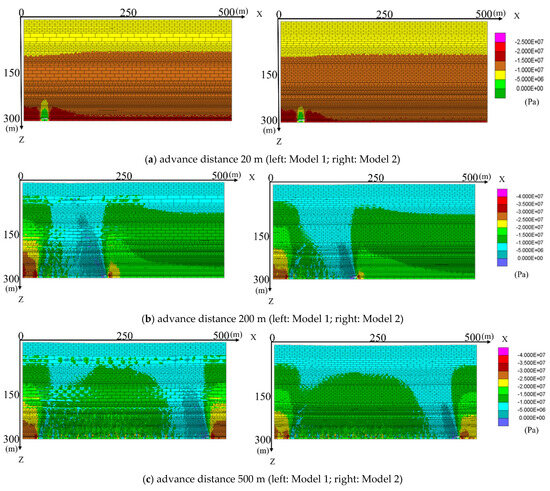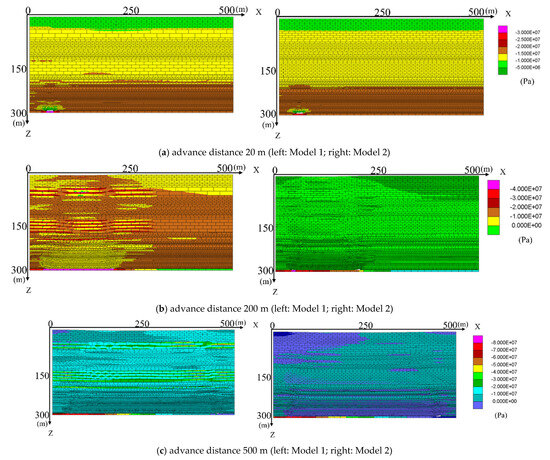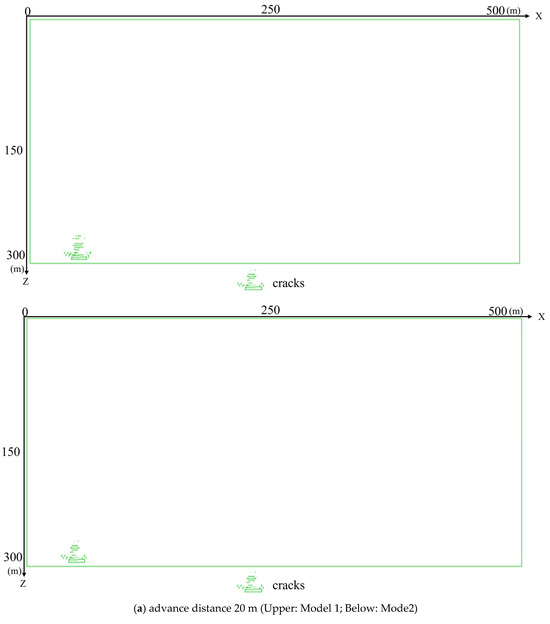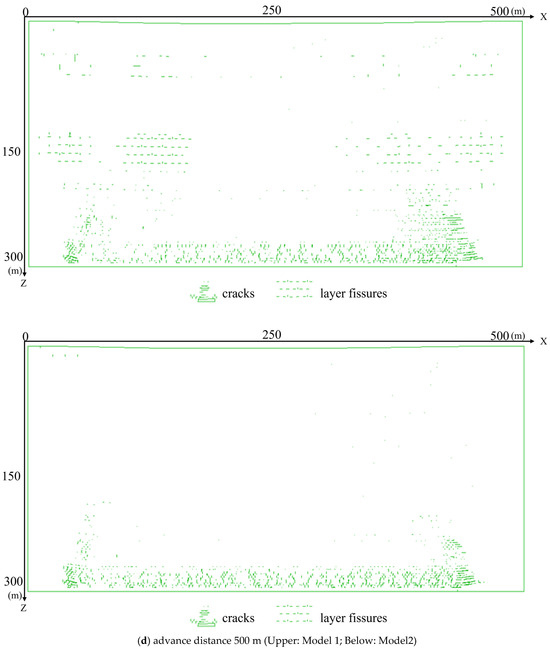Abstract
Overlying hard and thick igneous rocks pose numerous potential safety hazards during the exploitation of coal resources. Identifying the spatial distribution of igneous rocks and analyzing their impact on coal mining are a primary research concern. In this study, a coal mine was investigated in depth. Initially, based on the seismic information, the authors predicted the occurrence conditions of igneous rocks in coal measure strata. Subsequently, two models were developed via the UDEC software4.00: one with igneous layers and the other without. Using the simulation results, the change law of stress, the roof abscission layer, and roof strata subsidence in the overburden during coal face advancement were analyzed. Through a comparison of the simulation results, the hazard-causing mechanism of the igneous intrusion was discussed. Consequently, the occurrence of igneous rocks in the overburden is crucial for predicting potential safety hazards, and the seismic inversion method can be considered an effective tool for evaluating overlying igneous strata.
1. Introduction
The exploitation of coal resources has progressively transitioned to deeper mining levels in numerous coal fields. As mining depths increase, both the intensity and frequency of dynamic disasters have shown a significant upward trend. Rock bursts and gas outbursts, recognized as critical threats to mining safety, have recently manifested as coupled dynamic disasters in certain deep mining operations. Igneous rock formations, identified as a predominant type of mining overburden, exert substantial control over these dynamic disasters. This phenomenon has attracted growing scholarly attention, with an increasing number of researchers focusing on this critical subject.
Dynamic hazards associated with igneous-intruded coal mines have been extensively documented in recent studies, highlighting their significant impact on mining safety [1,2,3,4,5,6,7,8,9,10,11]. Igneous intrusions increased the spontaneous combustion risk of Daxing bituminous coal [1]. Coal bed methane occurrence was studied by collecting and classifying its parameters in different regions of igneous intrusion during coal mining [2]. Numerical modeling with a two-dimensional boundary element method was used to analyze the deformation and failure behavior of a coal seam and to understand the nature of gas flow into a roadway with igneous intrusion in Bangladesh [3]. The gas pressure and content of underlying coal seams was increased by the thermal effects of an igneous layer and the outburst risks from coal seams also rose in Haizi Coal Mine [4]. Igneous rock, considered the main key stratum, which suddenly broke and instantly released a tremendous amount of elastic strain energy, easily induced the occurrence of complex dynamic disasters, such as rock burst, water inrush, gas outburst, and surface subsidence [5]. An igneous intrusive layer affected in situ stress distribution and caused an increase in outburst risk in an underlying coal seam [6]. Lu et al. analyzed the microseismic effects of hard and thick igneous strata separation and fracturing and the corresponding evaluation index of fracturing intensity [7]. Zhou et al. explored the influence mechanism of coal oxidation on the outburst risk of coal seams after an igneous rock invasion [8]. The fracture failure step distance of hard and thick igneous rock was deduced based on the occurrence law of microseismic events, the characteristics of surface subsidence, and the change law of support resistance in the 10,416 working face at Yangliu coal mine [9]. Based on fractal theory and a clustering algorithm, a damage evolution law of multi-hole blasting igneous rock and a quantitative evaluation model of damage degree were proposed [10].
Igneous intrusions can have significant effects on coal seams, both physically and chemically [12,13,14,15,16,17,18,19]. The effects of igneous contact metamorphism were explored through the mineral and toxic trace element composition of low-sulfur coal in the Huaibei Coalfield [13]. Moroeng et al. studied the effects of a 0.4 m thick dolerite dyke on the mineralogy and geochemistry of Witbank coals, South Africa [14]. Wang N. et al. conducted a detailed study on geochemical and mineralogical responses to thermal alteration by an igneous intrusion in the Dashucun Coal Mine of the Fengfeng Coalfield [17,18]. The effect of pressure on the evolution of vitrinite graphitized mesophases was analyzed through an experimental study on anthracite under high temperatures and pressures [19].
In the meantime, geophysics detection has been applied to predictions of igneous rock [20,21,22,23,24,25,26]. The distribution of igneous rocks in eastern Yin’e Basin was revealed by 3D gravity and magnetic inversion [20]. Based on multi-component digital rocks, the authors used the finite element method and mathematical morphology method to analyze the influence mechanism of the above factors on the electrical conductivity mechanism of altered igneous rocks [21]. Li et al. presented a case study on igneous rock imaging through a strategy involving the joint use of a preferential filtering method and amplitude inversion affected by remanence in the Qikou depression in China [22]. Mhaddama et al. presented the interpretation of different magnetic analyses and a calculated 3D inversion model to provide important insights into the distribution of igneous rocks in central Iran [23]. Xiang et al. deeply studied the response characteristics of the gravity–magnetic–electric and physical properties of the Permian igneous rocks in the Sichuan Basin [24]. A 1445 km2 high-resolution 3D seismic reflection dataset was used to analyze the Permian large igneous province in the subsurface of the Tazhong area in the central Tarim Basin in northwestern China [25]. Yang X. et al. presented facies-controlled inversion for the prediction of volcanic rock and surrounding reservoir with near-offset seismic stack [26].
Notably, seismic detection techniques have been successfully applied to identify and characterize both igneous intrusion zones and thermally altered coal formations, providing critical insights into their spatial distribution and structural properties [27,28,29,30,31,32,33] Using laboratory experiments and numerical models, the velocity of igneous intrusions and its relationship with rock fracture toughness were investigated [27]. Chen T. et al. ocated the intrusion area of igneous rock using P-wave data and well logging data, combined with the impedance inversion method, seismic facies analysis, and the spectral decomposition technique [28]. Xu Y. et al. adopted the constrained sparse spike inverse modeling method to analyze and evaluate the intrusive area, the coked area, and the gas-enriched area [29]. Particle swarm optimization wave impedance inversion improved the resolution of fine structures in igneous rocks [30]. A forward modeling intrusion of igneous rock was performed and seismic attributes in detecting the ranges of the coal seams intruded on by igneous rocks were theoretically analyzed [31].
Igneous intrusions can have profound effects on coal seams, influencing their physical and chemical properties, structural integrity, and gas content. Understanding these effects is crucial for both geological research and practical applications in coal mining and energy production. However, previous studies have provided limited comprehensive analyses regarding the overlying igneous rocks in coal mining. This paper aims to investigate the geological conditions associated with igneous rock occurrences in a coal mine situated within the Huaibei Coalfield, while systematically analyzing their potential hazards and impacts on coal mining.
2. Methodology
2.1. Seismic Inversion
Seismic inversion, recognized as a powerful tool for data interpretation, has been extensively and successfully applied in the development of oil, gas, and coal resources. This technique effectively leverages the resolution advantages of both well log and seismic data. The implementation of acoustic impedance inversion typically relies on density (artificial gamma) and velocity (sonic transit time) well logs, which enable clear identification of coal seams. However, in the studied coal mine, igneous rock formations are nearly indistinguishable by the artificial gamma well logs (Figure 1). The authors calculated a new ‘density’ log by combining artificial gamma and apparent resistivity curves which would reflect the coal seam and igneous rock simultaneously. The method is known as the dual logging curve fusion technique. It is a curve fusion method that involves the selection, fusion, transformation, and error analysis of logging curves, ultimately resulting in an ideal synthetic density curve for inversion.

Figure 1.
Well log responses and new density logs of dual logging curve fusion technique.
Based on the integrated 3D seismic data and well log data, a model-based inversion approach was implemented to derive the acoustic impedance volume, which serves as a crucial parameter for subsurface characterization. The inversion process, conducted using industry-standard software (e.g., Hampson-Russell 10.4), involved three key steps, each requiring specialized geophysical expertise and rigorous quality control measures. First, seismic horizons were accurately calibrated through detailed well-to-seismic tie analysis, utilizing synthetic seismograms generated from density and sonic logs. This critical step ensured precise time–depth relationships and formed the foundation to establish an initial impedance model. The initial model incorporated both low-frequency trends derived from well data and structural constraints from interpreted seismic horizons. Subsequently, an iterative optimization process was implemented, where the calculated seismic profile was systematically compared with the actual seismic profile through forward modeling. During each iteration, the model parameters were adjusted using advanced algorithms (e.g., constrained sparse spike inversion or stochastic inversion) to minimize the difference between the synthetic and observed seismic data. This refinement process continued until optimal convergence was achieved, typically determined by reaching a predefined correlation coefficient threshold (e.g., >85%) between the modeled and actual seismic traces. The final optimized model, which demonstrated the closest approximation to the real seismic data through both quantitative metrics (e.g., normalized root mean square error <10%) and qualitative assessment (e.g., visual match of seismic events), was then regarded as the definitive inversion result. This high-resolution acoustic impedance volume not only provided crucial insights into lithological variations but also served as a fundamental input for subsequent reservoir characterization and geological modeling workflows.
2.2. Numerical Simulation
Numerical simulation serves as a powerful computational tool that replicates natural environments, phenomena, and evolutionary processes, enabling researchers to investigate the structural characteristics, morphological features, and kinematic behaviors of real-world prototypes through computer-based modeling. This approach not only complements experimental research and theoretical analysis but also provides valuable insights that address the limitations inherent in physical experimentation.
Universal Distinct Element Code (UDEC), developed by Itasca Consulting Group, Inc. in the United States, is a two-dimensional discrete element program for processing discontinuous media. The software is a commercial product that is mainly used for analysis in the fields of geotechnical engineering, rock mechanics, mining design, seismic engineering, and more [34,35].
In the process of conducting numerical simulations using UDEC, the first step is problem definition and model setup. This involves precisely defining the physical problem, such as determining the dimensions and boundaries of the surrounding rock mass and tunnel geometry in tunnel excavation simulations, and then assigning material properties including elastic modulus, Poisson’s ratio, density, and strength parameters for rock elements from laboratory or field data, and specifying joint properties if applicable. Boundary conditions are then set, with displacement fixation at certain boundaries and the application of external loads. Next is model generation, which requires creating a mesh of distinct elements to discretize the problem domain, choosing unstructured meshes for complex geometries and structured ones for simple shapes, and assembling the mesh while assigning proper material and boundary conditions. In numerical simulation setup, an appropriate time step is calculated based on material properties and element size to satisfy the CFL condition, a suitable solver is selected according to the problem type, and convergence criteria related to displacement or force residuals are set. Before running the simulation, the model is initialized with initial stress and displacement states and pre-existing fractures or voids are addressed. During the simulation, UDEC solves the governing equations over time, and key variables are monitored and recorded. Finally, in results analysis and interpretation, the data are visualized using UDEC’s tools or other software, relevant parameters are calculated, and a sensitivity analysis is performed by varying input parameters. Overall, each step in UDEC numerical simulation must be carefully executed with accurate data input to ensure reliable results.
3. Prediction of Igneous Layer Occurrence
3.1. Geological Setting
The coal mine is located in Suixi County, Anhui Province, China, and is owned by Huaibei Mining Co., Ltd. Its location is shown in Figure 2. It is classified as a coal and gas outburst mine and has nine coal seams. Among them, Coal Seams No. 3, No. 82, No. 10, and part of Coal Seam No. 72 are mineable.

Figure 2.
Location of the survey area.
In the Huaibei Coalfield, most mining areas underwent igneous activity during the Yanshanian period. The No. 72, No. 82, and No. 10 coal seams were significantly altered due to the presence of igneous layers. These extremely thick igneous layers underwent movement and deformation, which led to gas ejection and sudden roof collapse incidents during coal face mining. Therefore, predicting the occurrence of igneous rocks is a fundamental prerequisite for dynamic disaster risk assessment in this area.
3.2. Occurrence of Igneous Layers Prediction by Inversion
This study focuses on two thick igneous layers, identified as the ‘key layers’, which serve as the primary research targets. As revealed by borehole data, the No. 1 igneous rock layer, with an average thickness of 33.40 m, is stratigraphically positioned above the No. 5 coal seam, while the No. 2 igneous rock layer, averaging 40.24 m in thickness, overlies the No. 7 coal seam.
The raw seismic data used in this investigation were acquired by the China National Administration of Coal Geology in 2010 and subsequently processed using standard seismic data processing workflows. Figure 3 presents a representative post-stack seismic section along one inline direction, illustrating the seismic characteristics of the study area.

Figure 3.
Post-stack seismic data.
Due to their high acoustic impedance, the igneous layers can be clearly identified from the seismic inversion information in Figure 4. In the profile, the occurrence of coal seams is represented in green, while that of the igneous layers is represented in purple. The No. 82 and No. 10 coal seams, along with the two igneous layers, are also marked.

Figure 4.
Acoustic impedance profile.
The horizons were picked to calculate the time thicknesses of the igneous layers. The thickness information of the layers was then transformed using the site sampling velocity test and the occurrence range. Subsequently, the thickness distribution of the igneous layers was calculated, as shown in Figure 5. According to the figure, the thickness distribution of the igneous layers is heterogeneous, with the maximum thickness reaching 100 m. Moreover, the lower igneous layer is more widely distributed than the upper one.

Figure 5.
Occurrence range and thickness distribution of igneous layers.
4. Influence Analysis by Simulation
The igneous activity in the coal mine was relatively intense, and nearly all minable coal seams were affected by its intrusion. As a result, the impact of igneous rock intrusion on coal mining and its disaster-causing mechanism are of great significance for the mine’s safe production. In this study, the authors utilized the numerical simulation software UDEC to analyze the influence of overlying igneous rock on the advancement of the coal face.
4.1. Modeling
Based on the geological conditions and mechanical parameters of the strata (as shown in Table 1), two models were constructed. In accordance with the actual conditions of the Huaibei Coalfield described in Section 3.2, Model 1 was designed to include two igneous layers: a lower layer with a thickness of 45 m and an upper layer with a thickness of 25 m. In contrast, Model 2 did not have any igneous layer occurrences, as depicted in Figure 6. For the purpose of comparison, the length and height of both models were set to 600 m and 300 m, respectively. Vertical stress of 7.5 MPa was applied to the top of each model to simulate the overlying strata. According to the coal mining design, 50 m wide protective coal pillars were reserved on the left and right sides of the model. The mining height of the coal face was set at 4.0 m, and the excavation length was 500 m. Five survey lines were arranged within the models, and the strata lithology at the locations of these lines is presented in Table 2.

Table 1.
Mechanical parameters of overburden.

Figure 6.
Geological models for numerical simulation.

Table 2.
Horizons of survey line location.
4.2. In Situ Stress Simulation
In situ stress serves as the fundamental driving force behind both the deformation and failure of surrounding rock formations and the occurrence of mining-induced dynamic phenomena. A comprehensive understanding of in situ stress distribution provides a scientific theoretical foundation for optimizing mine roadway support systems and preventing coal–rock dynamic disasters. In this study, the authors developed comparative numerical models to systematically investigate the evolution of in situ stress distribution patterns in response to coal face advancement.
4.2.1. Vertical Stress
The distribution characteristics of vertical stress obtained from the numerical simulation are presented in Figure 7. In Model 1, a distinct vertical stress concentration phenomenon emerged in the surrounding rock adjacent to the goaf and around the arch angle sides of the lower igneous layer. As the coal face advanced, both the peak value of the vertical stress and the advanced influence range grew steadily. Stress concentration was observed in the two igneous layers. Specifically, the maximum vertical stress reached 36.4 Mpa, and the advanced influence range extended up to 32.4 m.

Figure 7.
Simulation results of vertical stress during coal face advancing.
In Model 2, an evident vertical stress concentration was present in the surrounding rock close to the goaf. As the coal face progressed, both the peak value of the vertical pressure and the range of its advanced influence kept increasing. In this case, the maximum vertical stress at the coal face reached 35.6 MPa, and the maximum advanced influence range measured 29.6 m. Therefore, compared to Model 2, in Model 1, apart from the goaf, vertical stress concentration also took place in the igneous layer, and it exhibited a more extensive advanced influence range.
4.2.2. Horizontal Stress
The simulation results of the horizontal stress are presented in Figure 8. These revealed a progressive evolution of stress distribution patterns during coal face advancement. In the initial stage (20 m advancement in Model 1), a localized horizontal stress concentration zone emerged within the lower igneous rock stratum. As the advance distance increased, distinct stress concentration phenomena developed simultaneously in both igneous layers, accompanied by the formation of an igneous abscission layer at approximately 200 m of face advancement. Ultimately, when the coal face reached the maximum advance distance of 500 m, extensive stress concentration areas were established throughout both the upper and lower igneous rock strata, indicating a complete redistribution of the stress field.

Figure 8.
Simulation results of horizontal stress during coal face advancing.
In Model 2, the overburden strata were fractured layer by layer, yet the horizontal stress exhibited gentle variations. The stress fluctuation range was narrow, and no distinct horizontal stress concentration was observed in the overburden. Consequently, the igneous layer, serving as the primary load-bearing structure of the overburden, exerted a significant impact on the alteration of horizontal stress within the overburden.
4.3. Roof Abscission Layer
The simulation results of the development of the roof abscission layer are presented in Figure 9. In Model 1, when the advancing distance reached approximately 20 m, transverse cracks emerged above the roof. As the advancing distance increased, axial cracks appeared in front of the coal face and behind the open–off cut. When the coal face advanced about 100 m, fissures of the roof abscission layer began to develop in the lower igneous layer. Subsequently, the fissures in the lower igneous layer further propagated and expanded. When the coal face advanced approximately 200 m, fissures started to emerge in the local area of the upper igneous layer. At this point, the abscission layer gradually formed in the two igneous layers. Finally, after the full mining of the coal face, the maximum development height of the water-conducting fracture was 142.4 m, which was about 35.6 times the mining thickness.




Figure 9.
Simulation results of roof abscission layer development.
In Model 2, transverse cracks emerged above the roof when the advance distance was approximately 20 m. As the advance distance increased, axial cracks manifested in front of the coal face and behind the open–off cut. Once the coal face had advanced 200 m, the abscission layer fissures in the middle of the goaf gradually underwent compaction and closure. At this stage, the water-conducting fissures were only developed in the vicinity of the open–off cut and the coal face. The maximum fracture development height measured 90.4 m, which was roughly 22.6 times the mining thickness. Consequently, compared with Model 2, in Model 1, the abscission layer formed within the igneous layers, and the height of the water-conducting fracture was greater.
4.4. Subsidence Simulation of Roof Strata
Figure 10 presents the strata subsidence data of the two models, which was recorded by the survey lines. As depicted in the figure, the maximum subsidence values of the lower igneous layer and the upper igneous layer, as recorded by line 4 and line 5, respectively, were approximately 2.78 m and 2.21 m in Model 1. In contrast, in Model 2, the subsidence of the igneous layers was about 3.03 m and 2.58 m. This indicates that the rock subsidence in Model 1 decreased by 8.25% and 14.34%, respectively, compared to Model 2. However, the law of subsidence variation in other strata, as recorded by line 1, line 2, and line 3, was nearly identical. Thus, it can be concluded that the igneous rock within the overburden exerted a certain degree of controlling influence on the subsidence of the upper strata.

Figure 10.
Simulation results of roof strata subsidence.
4.5. Discussion
This study used UDEC to build two models based on the geology of the Huaibei Coalfield to analyze the impact of overlying igneous rocks on coal mining face advancement. In the in situ stress simulation, for vertical stress, Model 1 had stress concentration in the goaf-surrounding rock and the lower igneous rock’s arch angle side. As the face advanced, the vertical stress peak and influence range grew, with both igneous layers affected. The max vertical stress was 36.4 MPa, and the influence range reached 32.4 m. In Model 2, stress concentrated near the goaf, with a max of 35.6 MPa and an influence range of 29.6 m. Model 1 had more extensive igneous rock stress concentration. For horizontal stress, in Model 1, stress evolved from local in the lower layer to widespread in both layers. In Model 2, the overlying rock’s horizontal stress changed gently, showing igneous rocks’ significant impact on horizontal stress. In the roof abscission layer simulation, in Model 1, fissures developed in two igneous layers, with a max water conducting fracture height of 142.4 m (35.6 times the mining height). In Model 2, goaf middle fissures compacted, and water-conducting fissures were near the open–off cut and face, with a max height of 90.4 m (22.6 times the mining height). Model 1 had a larger water-conducting fracture height. In roof strata subsidence simulation, Model 1’s lower and upper igneous layer subsidence was about 2.78 m and 2.21 m, respectively, while Model 2’s was 3.03 m and 2.58 m. Model 1’s subsidence decreased by 8.25% and 14.34%. The subsidence of other strata was similar, indicating igneous rocks’ control over upper strata subsidence. In short, igneous rocks greatly affect stress distribution, roof abscission layers, and strata subsidence in coal mining.
The presence of hard–thick igneous rocks leads to a large-scale horizontal and vertical stress concentration in the upper and lower layers of the igneous rock. This stress concentration can serve as a major driving force for coal and gas outbursts or water inrushes. The roof abscission layer, which acts as a reservoir for gas or water and is formed under specific geological conditions, may trigger dynamic disasters once the hard–thick igneous rock fractures. The data published on the official website also confirm that the occurrence of igneous rocks is an important inducing factor for disaster accidents. For example, in Wolonghu Coal Mine, two coal and gas outbursts in Coal Seam No.10 both took place near the magmatic intrusion boundary. On 25 April 2009, a coal and gas outburst accident happened in Coal Seam No.10 in Haizi Coal Mine, which is located under an extremely thick igneous rock layer. Also affected by the extremely thick magmatic rocks, a major water inrush accident occurred at the 745-working face of Haizi Coal Mine in 2005.
Moreover, the igneous rock within the overburden exerts a certain degree of control over the subsidence of the upper strata. It has played a positive role in alleviating surface subsidence, which is of great significance for the sustainable development of coal mining areas.
5. Conclusions
Seismic information was utilized to predict the occurrence of overlying igneous layers within the coal measure strata, and an in-depth analysis was carried out on their influence on coal mining. The following conclusions were drawn:
- (1)
- Conventional density logs were unable to effectively reflect the presence of igneous rock. However, the calculated artificial density logs exhibited a more favorable response. By integrating the calculated logs, igneous rock was distinctly manifested in the acoustic impedance inversion data. Based on this, the occurrence of igneous rock could be accurately predicted.
- (2)
- Serving as the primary load-bearing structure within the overburden, igneous rock exerts a profound influence on coal mining operations in the overburden strata. In Model 1, the horizontal stress exhibited a distinct stress concentration phenomenon, while in Model 2, no such concentration was observed. Regarding vertical stress, the concentration phenomenon was more widespread in Model 1. Moreover, the maximum fracture development height in Model 1 was significantly greater than that in Model 2. Additionally, the igneous rock within the overburden plays a role in controlling the subsidence of the upper strata to a certain extent.
- (3)
- The seismic inversion method can be regarded as an efficient means for predicting the occurrence of igneous rocks. This method offers a crucial foundation for the safety assessment of coal mining, empowering miners to more accurately anticipate potential geological risks and implement preventive measures in a timely manner.
Author Contributions
Conceptualization, J.L. and Y.F.; methodology, F.L.; software, J.L.; validation, T.F.; formal analysis, Y.F.; investigation, B.W.; resources, J.L.; data curation, F.L.; writing—original draft preparation, J.L.; writing—review and editing, B.W.; visualization, T.F.; supervision, Y.F.; project administration, F.L.; funding acquisition, J.L. All authors have read and agreed to the published version of the manuscript.
Funding
This study was financially supported by the Key Research and Development Program of Yunlong Lake Laboratory of Deep Underground Science and Engineering (No. 104023006), the Key Supported Project of the Joint Fund of the National Natural Science Foundation of China for Geology (No. U2444220), the National Key Research and Development Program of China (NO. 2022YFC3003304), and the National Natural Science Foundation of China (NOs. 42030810 and 42174165).
Institutional Review Board Statement
Not applicable.
Informed Consent Statement
Not applicable.
Data Availability Statement
The original contributions presented in this study are included in the article. Further inquiries can be directed to the corresponding author.
Acknowledgments
We would like to express our gratitude to the anonymous reviewers and the editors.
Conflicts of Interest
Author Fanjia Li was employed by the company Jiangsu CYP Industry Technology Research Institute, Ltd. The remaining authors declare that the research was conducted in the absence of any commercial or financial relationships that could be construed as a potential conflict of interest.
References
- Shi, Q.L.; Qin, B.T.; Liang, H.J.; Gao, Y.; Bi, Q.; Qu, B. Effects of igneous intrusions on the structure and spontaneous combustion propensity of coal: A case study of bituminous coal in Daxing Mine, China. Fuel 2018, 216, 181–189. [Google Scholar] [CrossRef]
- Chen, H.; Wang, S.; Zhang, X.; Zhao, Y.; Zhang, H. A study of chemical structural evolution of thermally altered coal and its effect on graphitization. Fuel 2021, 283, 119295. [Google Scholar] [CrossRef]
- Islam, M.R.; Shinjo, R. Numerical simulation of stress distributions and displacements around an entry roadway with igneous intrusion and potential sources of seam gas emission of the Barapukuria coal mine, NW Bangladesh. Int. J. Coal Geol. 2009, 78, 249–262. [Google Scholar] [CrossRef]
- Wang, L.; Cheng, L.B.; Cheng, Y.P.; Yin, G.Z.; Xu, C.; Jin, K.; Yang, Q.L. Characteristics and evolutions of gas dynamic disaster under igneous intrusions and its control technologies. J. Nat. Gas Sci. Eng. 2014, 18, 164–174. [Google Scholar] [CrossRef]
- Wang, L.; Cheng, Y.P.; Xu, C.; An, F.H.; Jin, K.; Zhang, X.L. The controlling effect of thick-hard igneous rock on pressure relief gas drainage and dynamic disasters in outburst coal seams. Nat. Hazards 2013, 66, 1221–1241. [Google Scholar] [CrossRef]
- Wang, L.; Liu, S.M.; Cheng, Y.P.; Yin, G.Z.; Guo, P.K.; Mou, J.H. The effects of magma intrusion on localized stress distribution and its implications for coal mine outburst hazards. Eng. Geol. 2017, 218, 12–21. [Google Scholar] [CrossRef]
- Lu, C.P.; Liu, Y.; Wang, H. Microseismic signals of double-layer hard and thick igneous strata separation and fracturing. Int. J. Coal Geol. 2016, 160–161, 28–41. [Google Scholar] [CrossRef]
- Zhou, B.Z.; Yang, S.Q.; Wang, C.J.; Cai, J.W.; Xu, Q.; Sang, N.W. Experimental study on the influence of coal oxidation on coal and gas outburst during invasion of igneous rocks into coal seams. Process Saf. Environ. Prot. 2019, 124, 213–222. [Google Scholar] [CrossRef]
- Jiang, L.S.; Wu, Q.S.; Wu, Q.L.; Wang, P.; Xue, Y.C.; Kong, P.; Gong, B. Fracture failure analysis of hard and thick key layer and its dynamic response characteristics. Eng. Fail. Anal. 2019, 98, 118–130. [Google Scholar] [CrossRef]
- Zhao, H.B.; Tu, S.H.; Miao, K.J.; Tang, L.; Ma, J.Y.; Guo, B.H. Damage evolution law of multi hole blasting igneous rock and quantitative evaluation model of damage degree based on fractal theory and clustering algorithm. Sci. Rep. 2024, 14, 15880. [Google Scholar] [CrossRef]
- Wu, Q.L.; Wu, Q.S.; Xue, Y.C.; Kong, P.; Gong, B. Analysis of Overlying Strata Movement and Disaster-Causing Effects of Coal Mining Face under the Action of Hard Thick Igneous Rock. Processes 2018, 6, 15. [Google Scholar] [CrossRef]
- Chen, Y.L.; Qin, Y.; Ji, M.; Duan, H.F.; Wu, C.F.; Shi, Q.M.; Zhang, X.Y.; Wang, Z.W. Influence of lamprophyre sills on coal metamorphism, coalbed gas composition and coalbed gas occurrence in the Tongxin Minefield, Datong Coalfield. China. Int. J. Coal Geol. 2020, 217, 103286. [Google Scholar] [CrossRef]
- Liu, B.X.; Song, X.P.; Wang, N.; Nechaev, V.P.; Zhu, Q.L.; Zhang, B.W.; Tang, S.H.; Sun, R.Y. Effects of igneous contact metamorphism on the mineral and toxic trace element composition of low-sulfur coal in the Huaibei Coalfield, eastern China. Appl. Geochem. 2025, 180, 106278. [Google Scholar] [CrossRef]
- Moroeng, O.M.; Murathi, B.; Wagner, N.J. Enrichment of rare earth elements in epigenetic dolomite occurring in contact metamorphosed Witbank coals (South Africa). Int. J. Coal Geol. 2024, 282, 104405. [Google Scholar] [CrossRef]
- Chen, H.D.; Jiang, J.Y.; Chen, X.J.; Xu, C.T. Differences in coal bed methane occurrence for different regions of igneous erosion in the Haizi coal mine, Huaibei coalfield, China. J. Nat. Gas Sci. Eng. 2014, 21, 732–737. [Google Scholar] [CrossRef]
- Chukwuma, K.; Tsikos, H.; Horsfield, B.; Schulz, H.-M.; Harris, N.B.; Frazenburg, M. The effects of Jurassic igneous intrusions on the generation and retention of gas shale in the Lower Permian source-reservoir shales of Karoo Basin, South Africa. Int. J. Coal Geol. 2023, 269, 104219. [Google Scholar] [CrossRef]
- Wang, N.; Esterle, J.S.; Rodrigues, S.; Hower, J.C.; Dai, S. Insights on the regional thermal evolution from semianthracite petrology of the Fengfeng coalfield, China. Int. J. Coal Geol. 2024, 290, 104548. [Google Scholar] [CrossRef]
- Wang, N.; Dai, S.; Esterle, J.; Moore, T.; Zhao, L. Geochemical and mineralogical responses to thermal alteration by an igneous intrusion in the Dashucun Coal Mine of the Fengfeng coalfield, Hebei, North China. Appl. Geochem. 2024, 160, 105877. [Google Scholar] [CrossRef]
- Wang, Y.; Yao, S. Effect of pressure on the evolution of vitrinite graphitized mesophases: An experimental study on anthracite under high temperature and pressure. Int. J. Coal Geol. 2023, 267, 104187. [Google Scholar] [CrossRef]
- Duan, R.F.; Li, X.S.; Liu, J.L.; Guo, C.A.; Qiang, Y.Y.; Liu, L.J. Distribution of magmatic rocks in eastern Yin’e Basin revealed by 3D gravity and magnetic inversion. J. Appl. Geophys. 2023, 215, 105068. [Google Scholar]
- Guo, Y.H.; Pan, B.Z.; Feng, J.; Guan, Y.; Wang, Q.H.; Zang, L.H.; A, R.H.; Wang, X.R.; Zhang, N.Y.; Zhang, P.J.; et al. Conductive mechanism and low resistivity analysis of altered igneous rock in the South China Sea. Chin. J. Geophys. 2023, 66, 4753–4764. (In Chinese) [Google Scholar]
- Li, S.L.; Dai, X.P. Application of magnetic amplitude inversion in the identification of igneous rocks in superimposed basins: A case study in Qikou depression. Appl. Geophys. 2024, 21, 1–10. [Google Scholar] [CrossRef]
- Moghaddama, M.M.; Mirzaeia, S.; Abedib, M. New Insights into Interpretation of Aeromagnetic Data for Distribution of Igneous Rocks in Central Iran. Russ. Geol. Geophys. 2022, 63, 1061–1077. [Google Scholar] [CrossRef]
- Xiang, K.; Yan, L.J.; Wang, Z.G.; Lu, Y. Comprehensive Physical Properties and Exploration Potential of the Permian Igneous Rocks in the Southwestern Sichuan Basin. Minerals 2022, 12, 789. [Google Scholar] [CrossRef]
- Yang, J.F.; Zhu, W.B.; Guan, D.; Zhu, B.B.; Yuan, L.S.; Xiang, X.M.; Su, J.B.; He, J.W.; Wu, X.H. 3D seismic interpretation of subsurface eruptive centers in a Permian large igneous province, Tazhong Uplift, central Tarim Basin, NW China. Int. J. Earth Sci. 2016, 105, 2311–2326. [Google Scholar] [CrossRef]
- Yang, X.L.; Wang, F.L.; Zhang, M. Facies-controlled inversion the prediction of volcanic rock and surrounding reservoir with near offset stack seismic: A case study in No.2 structure of Nanpu sag. Prog. Geophys. 2022, 37, 1640–1649. (In Chinese) [Google Scholar]
- Gaete, A.; Maccaferri, F.; Furst, S.; Pinel, V. Investigating the velocity of igneous intrusions and its relation with rock fracture toughness: Insights from laboratory experiments and numerical model. Geophys. J. Int. 2025, 240, 638–651. [Google Scholar] [CrossRef]
- Chen, T.J.; Cui, R.F.; Xu, Y.Z.; Wang, X. Method to locate igneous rock intrusion of coal bed using P-wave data. Procedia Earth Planet. Sci. 2009, 1, 963–969. [Google Scholar]
- Xu, Y.Z.; Cui, R.F.; Huang, W.C.; Chen, T.J.; Chen, S.Z.; Dong, S.H. Reflectivity forward modeling and a CSSI method seismic inversion study of igneous intrusive area, coked area, and gas-enriched area located within a coal seam. Min. Sci. Technol. 2009, 19, 457–462. [Google Scholar] [CrossRef]
- Yang, H.J.; Xu, Y.Z.; Peng, G.X.; Yu, G.P.; Chen, M.P.; Duan, W.S.; Zhu, Y.F.; Cui, Y.F.; Wang, X.J. Particle swarm optimization and its application to seismic inversion of igneous rocks. Int. J. Min. Sci. Technol. 2017, 27, 349–357. [Google Scholar] [CrossRef]
- Chen, F.B.; Zhu, J.; Wang, J.B.; Yang, Y.; Iqbal, I.; Zhang, T.Y.; Li, P. Seismic attribute analysis of coal seams intruded by igneous rock. Pet. Sci. Technol. 2022, 40, 1878–1897. [Google Scholar] [CrossRef]
- Xu, C.; Cheng, Y.P.; Ren, T.; Wang, L.; Kong, S.L.; Lu, S.Q. Gas ejection accident analysis in bed splitting under igneous layers and the associated control technologies: A case study in the The Mine, Huaibei Coalfield, China. Nat. Hazards 2014, 71, 109–134. [Google Scholar] [CrossRef]
- Saeed, A.; Gholam, R.L.; Mohammad, G. Estimating engineering properties of igneous rocks using semi-automatic petrographic analysis. Bull. Eng. Geol. Environ. 2019, 78, 2299–2314. [Google Scholar]
- Liu, Y.H.; Kong, D.Z.; Li, P.; Wen, Z.J.; Li, F.; Zuo, Y.J.; Wu, G.Y. The migration and evolution law of overlying strata and the instability and failure characteristics of end face roof under the condition of ascending mining in close distance coal seam: Case study. Eng. Fail. Anal. 2024, 165, 108809. [Google Scholar]
- Almenara, J.T.; Skretting, E.; Holter, K.G.; Høien, A.H. Design of Rock Support in Hard and Layered Rock Masses Using a Hybrid Method: A Study Based on the Construction of the New Skarvberg Tunnel, Norway. Rock Mech. Rock Eng. 2024, 57, 10491–10532. [Google Scholar] [CrossRef]
Disclaimer/Publisher’s Note: The statements, opinions and data contained in all publications are solely those of the individual author(s) and contributor(s) and not of MDPI and/or the editor(s). MDPI and/or the editor(s) disclaim responsibility for any injury to people or property resulting from any ideas, methods, instructions or products referred to in the content. |
© 2025 by the authors. Licensee MDPI, Basel, Switzerland. This article is an open access article distributed under the terms and conditions of the Creative Commons Attribution (CC BY) license (https://creativecommons.org/licenses/by/4.0/).